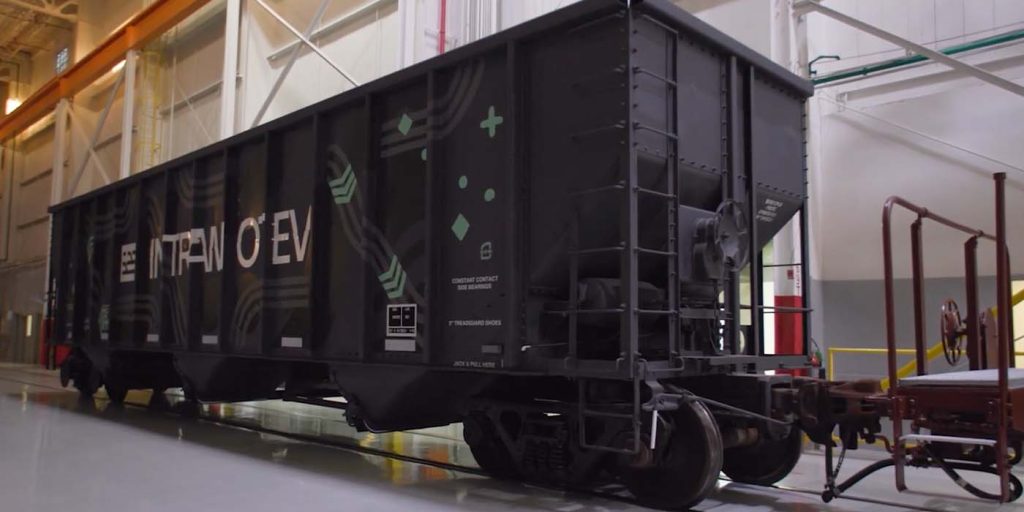
A young tech company called Intramotev has developed zero-emissions freight mobility solutions that could help significantly decarbonize (and revitalize) a major industry in the US. Following a new $200,000 grant from the state of Michigan, Intramotev looks to deploy three of its self-propelled battery-electric railcars in the state later this year.
Intramotev is a St. Louis-based group founded in 2020 that describes itself as a “high-technology company developing autonomous, zero-emission rail solutions that decrease costs, increase usage and safety, and promote environmental responsibility.”
In a few short years, the company has been able to develop unique freight solutions using software and battery-electric propulsion technology. This includes the TugVolt battery electric railcar (seen above and below), which can decouple from the consist (the group of railcars as a whole) and operate independently for first and last mile legs.
The company has also developed a ReVolt railcar that can be positioned to stay within the train’s consist and capture energy using regenerative braking to reduce diesel consumption from the line’s locomotive. Intramotev CEO Dr. Timothy Luchini described the potential for zero-emissions freight in a video you can also view below:
Technologies are ready to be adopted today and we don’t have to wait for a breakthrough in those technologies to make it happen. We’re integrating it all together into this new innovative platform that gives rail a competetive edge for the next 200 years.
Following a fresh grant from the state of Michigan, Intramotev appears poised to begin deploying its TugVolt electric railcars before the end of 2023.

Intramotev nabs $200k to develop, deliver electric railcars
Intramotev shared details of the grant this morning, which includes $200,000 from Michigan’s Office of Future Mobility and Electrification (OFME). The funding will be used to further develop Intramotev’s TugVolt kit – which can be retrofitted to existing railcars so they become battery-electric and move independently.
Intramotev states that highway freight trucks produce an estimated 433 million tons of carbon emissions annually, while nearly a million freight railcars sit idle every day in switching yards. The company looks to alleviate the congestion and pollution on these roadways by hardening freight shipment certainty through electric performance. All while helping meet the Federal Railroad Administration’s Climate Challenge to reach net-zero carbon emissions by 2050.
We’ve covered plenty of emerging electric locomotives in the past, but Intramotev is trying to remove that dependency altogether. Per CEO Timothy Luchini, PhD:
We are excited to partner with Michigan’s Office of Future Mobility and Electrification to usher in a new era of industrial revitalization. Utilizing the most advanced battery-electric technology and other proprietary tools, we look to apply the packetization of the internet model to freight logistics initially on short captive routes and remove the actual distance then rapidly expanding to the full network of 140,000 miles of existing US track without additional infrastructure. We envision a future where freight can move itself without waiting for a locomotive, making the system more efficient and environmentally friendly.
The grant from Michigan’s OFME is expected to help Intramotev deploy three of its TugVolt self-propelled railcars at a mining site in the state’s Upper Peninsula in late 2023. If and when that does happen, the parties state it will be the first deployment of self-propelled, battery-electric railcars for commercial use in a freight rail operation anywhere in the world.
You can learn more about Intramotev and watch the TugVolt get summoned using a smartphone in the video below.
Author: Scooter Doll
Source: Electrek



